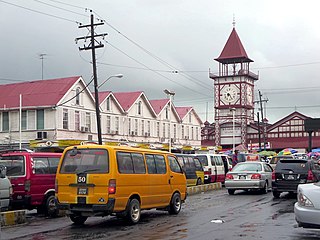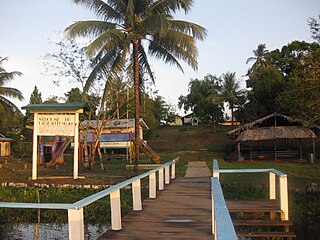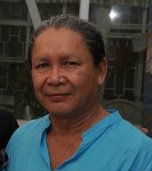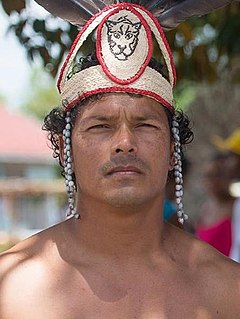
Georgetown is the capital and largest city of Guyana. It is situated in Demerara-Mahaica, region 4, on the Atlantic Ocean coast, at the mouth of the Demerara River. It is nicknamed the "Garden City of the Caribbean." It is the retail, administrative, and financial services centre of the country, and the city accounts for a large portion of Guyana's GDP. The city recorded a population of 118,363 in the 2012 census.

Demerara-Mahaica is a region of Guyana, bordering the Atlantic Ocean to the north, the region of Mahaica-Berbice to the east, the region of Upper Demerara-Berbice to the south and the region of Essequibo Islands-West Demerara to the west.
Lusignan is a community in Demerara-Mahaica region of Guyana and approximately 16 km from the capital city Georgetown. Located on the East Coast of Demerara, it has population of 1,868 persons as of 2012 mostly Indo-Guyanese.

Kabakaburi is an Amerindian village in the Pomeroon-Supenaam Region of Guyana on the Pomeroon River, 56 km (35 mi) from its mouth. The village was founded in 1845 by William Henry Brett on the location where Fort Durban used to be.
The Mahaica River is a small river in northern Guyana that drains into the Atlantic Ocean. The village of Mahaica is found at its mouth.
The Railways of Guyana comprised two public railways, the Demerara-Berbice Railway and the Demerara-Essequibo railway. There are also several industrial railways mainly for the bauxite industry. The Demerara-Berbice Railway is the oldest in South America. None of the railways are in operation in the 21st century.
Campbelltown is an Amerindian village in the Potaro-Siparuni Region of Guyana, north of Mahdia. The village has been named after Stephen Campbell, the first Amerindian member of Parliament in Guyana.
Jonestown is a village in the Demerara-Mahaica region of Guyana. The old name of the village was Voorzigtigheid. The village is located 37.5 kilometres from Georgetown between Hand-en-Veldt and the Atlantic Ocean, and near the town of Mahaica. Therefore, it tends to be called "Jonestown, Mahaica" or "Jonestown, Mahaica, ECD", even today, although by current Guyanese administrative regions it is in Demerara-Mahaica.
St. Monica Karawab is a village in the Pomeroon-Supenaam region of Guyana. The village is an Amerindian village.

George Simon was a Guyanese Lokono Arawak artist and archaeologist. He was the founder and mentor of the Lokono Artists Group, a group of Lokono artists from Guyana, based primarily in Simon's hometown of St. Cuthbert's Mission. Simon was widely regarded as one of the leading Guyanese artists of his generation, and his paintings are notable for their explorations of Amerindian culture and the Guyanese environment. He was also recognized for his achievements as an educator, his efforts to develop opportunities for Amerindian artists in Guyana, and for his work as an archaeologist.
Oswald ("Ossie") Hussein is a Guyanese artist of Lokono (Arawak) descent. Though he occasionally works in other mediums, he is best known for his wooden sculptures which explore various dimensions of Arawak Amerindian culture and tradition. Hussein first achieved national recognition when he won first prize in Guyana's National Exhibition of the Visual Arts in 1989, and since that time he has gone on to become one of Guyana's most celebrated artists and a leading figure in Guyanese sculpture. Along with his half-brother, George Simon, he is one of the most prominent members of the Lokono Artists Group. His work has been displayed in numerous exhibitions in Guyana, Barbados, and the United Kingdom.

Indigenous peoples in Guyana, Native Guyanese, or Amerindian Guyanese are Guyanese people who are of indigenous ancestry. They comprise approximately 9.16% of Guyana's population. Amerindians are credited with the invention of the canoe, as well as Cassava-based dishes and Guyanese pepperpot, the national dish of Guyana. Amerindian languages have also been incorporated in the lexicon of Guyanese Creole.
The Lokono or Arawak are an Arawak people native to northern coastal areas of South America. Today, approximately 10,000 Lokono live primarily along the coasts and rivers of Venezuela, Guyana, Suriname, Barbados and French Guiana. They speak the Arawak language, the eponymous language of the Arawakan language family, as well as various Creole languages, and English.
Mahaica is a village located in region 4 of Demerara-Mahaica in Guyana. Mahaica is often used as a subregion for the adjoining villages near the Mahaica River like Hand-en-Veldt, Good Hope, Chelsey Park, and Jonestown, which is often referred to as Mahaica or its old Dutch plantation name Voorzigtigheid.
Paradise is a village located in the Demerara-Mahaica region of Guyana, and used to be its regional capital, however the administrative building burnt down in 2006, and the regional capital moved to Triumph.
Better Hope is a village located in the Demerara-Mahaica region of Guyana. The village has been named after the Plantation Betterhoop It was originally a fishing village with many working on the sugar estates and nearby farms. The majority of the population is Indo-Guyanese with a minority of Afro-Guyanese.
Triumph is a village and regional capital of the Demerara-Mahaica region in Guyana.

Lenox Ron O'Dell Shuman is a Guyanese politician who has served as Deputy Speaker of the National Assembly of Guyana since 2 September 2020. He is also the founder and leader of the Liberty and Justice Party.
Yvonne Fredericks-Pearson is a Guyanese politician. She has been a member of the National Assembly since 2015. She served as Toshao of Mainstay/Whyaka from 1994 to 2012.

Santa Mission is a village in the Essequibo Islands-West Demerara Region of Guyana. Santa Mission is mainly inhabited by Lokono Amerindians. The village is located on the Kamuni Creek, a tributary of the Demerara River. The village of Hopetown, an early Chinese settlement, is located about 15 kilometres (9.3 mi) from Santa Mission.







